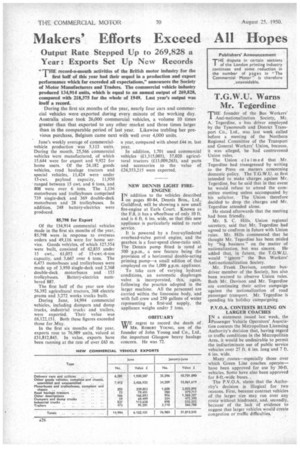Makers' Efforts Exceed All Hopes
Page 28

If you've noticed an error in this article please click here to report it so we can fix it.
Output Rate Stepped Up to 269,828 a Year : Exports Set Up New Records
"'THE record-a-month activities of the British motor industry for the first half of this year had their sequel in a production and export performance which far exceeded all expectations," announces the Society of Motor Manufacturers and Traders. The commercial vehicle industry produced 134,914 units, which is equal to an annual output of 269,828, compared with 218,375 for the whole of 1949. Last year's output was itself a record.
During the first six months of the year, nearly four cars and commercial vehicles were exported during every minute of the working day. Australia alone took 26,000 commercial vehicles, a volume 10 times greater than that exported to any other market and three times larger than in the comparable period of last year. Likewise trebling her previous purchase. Belgium came next With well over 4,000 units.
June's weekly average of commercialvehicle production was 5,113 units. During the month, 25,566 commercial vehicles were manufactured, of which 15.644 were for export and 9,922 for home users. Of the 24,182 goods vehicles, road haulage tractors and special vehicles, 11,424 were under 15-cwt. payload capacity, 11,950 ranged between 15 cwt. and 6 tons, and 808 were over 6 tons. The 1,136 motorbuses and trolleybuses comprised 739 single-deck and 369 double-deck motorbuses and 28 trolleybuses. In addition. 248 battery-electrics were produced.
85,798 for Export
Of the 134,914 commercial vehicles made in the first six months of the year, 85,798 were in response to overseas orders and 49,116 were for home service. Goods vehicles, of which 127,554 were built, consisted of 62,835 under 15 cwt.. 61,052 of 15-cwt.-6-ton Capacity, and 3,667 over 6 tons. The 6,473 motorbuses and trolleybuses were made up of 3,950 single-deck and 2,368 double-deck motorbuses and 155 trolleybuses. Battery-electrics numbered 887.
The first half of the year saw also 56.392 agricultural tractors. 368 electric prams and 3,272 works trucks built.
During June, 14,994 commercial vehicles, including dumpers and dump trucks, industrial trucks and trailers, were exported. Their value was £6,122.151. Both these figures exceeded those for May.
In the first six months of the .year, exports rose to 76,989 units, valued at £31,812,845. In value, exports have been running at the rate of over £63 m.
a year, compared with about £44 m, last year.
In addition, 1,701 used commercial vehicles (£1,315,003), 37,020 agricultural tractors (£13,009,263), and parts and accessories to the value of £24,353,215 were exported.
NEW DENNIS LIGHT FIREENGINE
I N addition to the vehicles described on pages 80-84, Dennis Bros., Ltd., Guildford, will be showing a new small fire-engine at Earls Court. Known as the F.8, it has a Wheelbase of only 10 ft. and is 6 ft. 6 ins, wide, so that this new appliance is particularly suited to rural service.
It is powered by a four-cylindered overhead-valve petrol engine, and the gearbox is a four-speed close-ratio unit. The Dennis pump fitted is rated at 500 g.p.m., a new feature being the provision of a horizontal double-acting priming pump-a small edition of that employed on the 1,000 g.p.m. appliance.
To take care of varying hydrant conditions, an automatic diaphragm valve is incorporated, this, again, following the practice adopted in the larger machine. All the personnel are carried within the limousine body, and with full crew and 250 gallons of water representing a first-aid supply, the appliance weighs under 5 tons.
. OBITUARY
WiE regret to record the death of YY MR. ROBERT YOUNG, son of the founder of John Young and Co„ Ltd., the important Glasgow heavy haulage concern. He was 72. T.G.W.U. Warns Mr. Tegerdine
THE founder of the Bus Workers' Anti-nationalization Society, Mr. A. Tegerdine, a bus driver employed by the Tynemouth and District Transport Co., Ltd., was last week called before a meeting of the Northern Regional Committee of the Transport and General Workers' Union, because. it was alleged, he had contravened Union rules.
The Union claimed that Mr. Tegerdine had transgressed by writing to the Press on matters concerning domestic policy. The T.G.W.U. at first intended to make charges against Mr. Tegerdine, but he said that in that event he would refuse to attend the committee meeting unless accompanied by his solicitor. The Union therefore decided to drop the charges and Mr. Tegerdine attended alone.
He stated afterwards that the meeting had been friendly.
Mr. S. C. Hills, Union regional secretary, said that Mr. Tegerdine had agreed to conform in future with Union rules. Mr. Hills commented that he thought Mr. Tegerdine has been misled by "big business" on the matter of nationalization, but was sincere. He added that,. in future, the T.G.W.U. would " ignore " the Bus Workers' Anti-nationalization Society.
Mr. Frank Davison, another busdriver member of the Society, has also been warned to observe Union rules. Both Mr. Davison and Mr. Tegerdine are continuing their active campaign against the nationalization of road passenger transport. Mr. Tegerdine is spending his holiday campaigning.
P. V.O.A. CONTESTS RULING ON LARGER COACHES
I N a statement issued last week, the
Passenger Vehicle Operators' Association contests the Metropolitan Licensing Authority's decision that, having regard to traffic conditions in the Metropolitan Area, it would be undesirable to permit the indiscriminate use of public service vehicles over 27 ft. 6 ins, long and 7 ft. 6 ins. wide.
Many routes-especially those over which Green Line coaches operatehave been approved for use by 30-ft. vehicles. Some have also been approved for 8-ft.-wide buses., The P.V.O.A. states that the Authority's decision is illogical for two reasons. First, because contract vehicles of the larger size may run over any route without hindrance, and, secondly, because of the lack of evidence to suggest that larger vehicles would create congestion or traffic difficulties.












































































